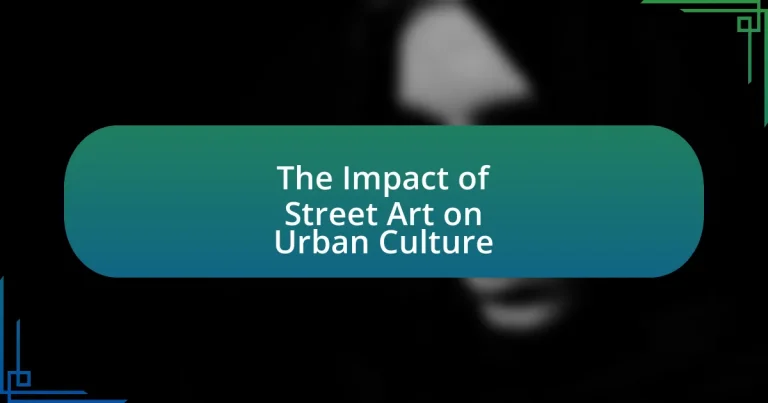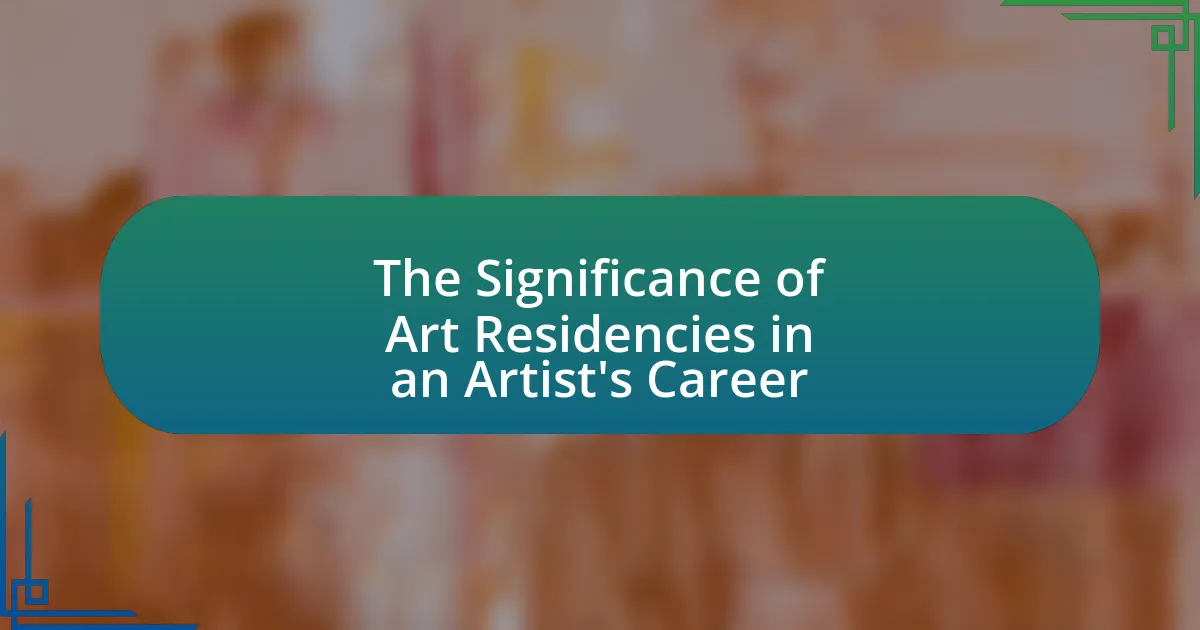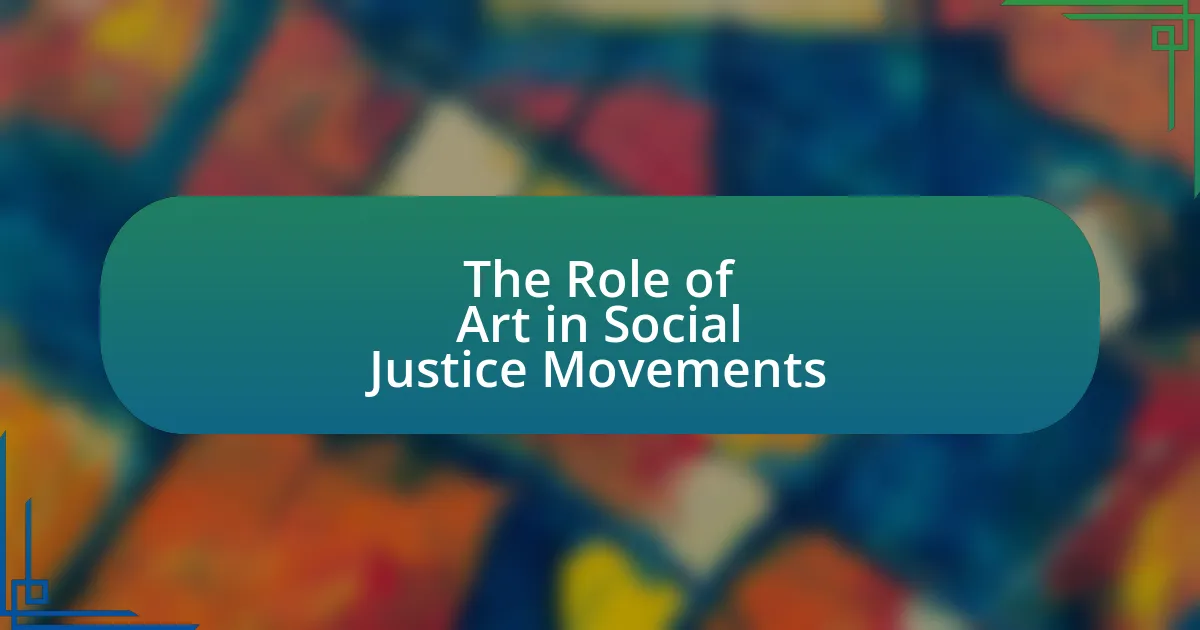Street art plays a significant role in shaping urban culture by transforming public spaces into vibrant platforms for artistic expression and social commentary. It reflects community identity, addresses local issues, and fosters dialogue among residents, contributing to increased tourism and local pride in cities like Berlin and Melbourne. The article explores how street art influences community identity, enhances visual appeal, promotes social change, and faces challenges such as legal restrictions and societal perceptions. Additionally, it examines the economic benefits of street art for local businesses and the importance of community engagement in fostering acceptance of this art form.

What is the Impact of Street Art on Urban Culture?
Street art significantly influences urban culture by transforming public spaces into platforms for artistic expression and social commentary. This form of art often reflects the community’s identity, addressing local issues and fostering dialogue among residents. For instance, studies show that cities with vibrant street art scenes, such as Berlin and Melbourne, experience increased tourism and community engagement, as street art attracts visitors and encourages local pride. Additionally, street art can challenge societal norms and provoke thought, making it a powerful tool for activism and change within urban environments.
How does street art influence community identity?
Street art significantly influences community identity by serving as a visual representation of local culture, values, and social issues. It fosters a sense of belonging and pride among residents, as murals and graffiti often reflect the unique history and experiences of the community. For instance, in neighborhoods like Wynwood in Miami, street art has transformed the area into a cultural hub, attracting tourism and revitalizing local businesses, which reinforces community identity. Studies have shown that communities with vibrant street art report higher levels of social cohesion and engagement, as these artworks often spark conversations and encourage community participation in local events.
What role does street art play in expressing local culture?
Street art serves as a vital medium for expressing local culture by reflecting the community’s identity, values, and social issues. It often incorporates local symbols, languages, and themes that resonate with residents, making it a form of cultural dialogue. For instance, murals in neighborhoods can depict historical events or celebrate local heroes, thereby fostering a sense of pride and belonging among community members. Research indicates that street art can enhance public spaces and encourage community engagement, as seen in cities like Berlin and Melbourne, where local artists use their work to address social justice issues and cultural narratives. This connection between street art and local culture underscores its role as both an artistic expression and a catalyst for community cohesion.
How does street art foster a sense of belonging among residents?
Street art fosters a sense of belonging among residents by transforming public spaces into shared cultural expressions that reflect local identity. This form of art often incorporates community themes, historical references, and social issues relevant to the area, allowing residents to see their experiences and values represented visually. For instance, a study by the University of California found that neighborhoods with vibrant street art reported higher levels of community engagement and pride, as residents felt a connection to the artwork and, by extension, to each other. This visual representation of community narratives helps to create a collective identity, reinforcing social ties and encouraging participation in local events and initiatives.
What are the social implications of street art?
Street art has significant social implications, as it serves as a medium for expression, community engagement, and social commentary. It often reflects the voices of marginalized groups, challenging societal norms and sparking dialogue on issues such as inequality, politics, and identity. For instance, the rise of street art in cities like Berlin and New York has been linked to movements advocating for social justice, with artists using public spaces to raise awareness about pressing social issues. Studies indicate that street art can foster community pride and cohesion, as seen in neighborhoods that embrace local artists, enhancing cultural identity and promoting tourism.
How does street art challenge societal norms and values?
Street art challenges societal norms and values by using public spaces to convey messages that critique authority, promote social change, and express marginalized voices. This form of art often addresses issues such as inequality, political corruption, and cultural identity, which are typically overlooked in mainstream discourse. For example, the works of artists like Banksy and Shepard Fairey have sparked conversations about consumerism and social justice, illustrating how street art can provoke thought and inspire action among viewers. By transforming urban environments into platforms for dialogue, street art disrupts conventional perceptions of art and its role in society, thereby redefining cultural narratives.
In what ways does street art promote social change?
Street art promotes social change by raising awareness of social issues, fostering community engagement, and challenging societal norms. Artists use public spaces to convey messages about inequality, injustice, and political dissent, making these topics accessible to a broader audience. For instance, the work of Banksy often critiques consumerism and war, prompting public discourse on these subjects. Additionally, street art can beautify neglected urban areas, transforming them into spaces for dialogue and community pride, as seen in initiatives like the Wynwood Walls in Miami, which revitalized a struggling neighborhood through art. This combination of visibility and engagement empowers communities to advocate for change and express their identities.
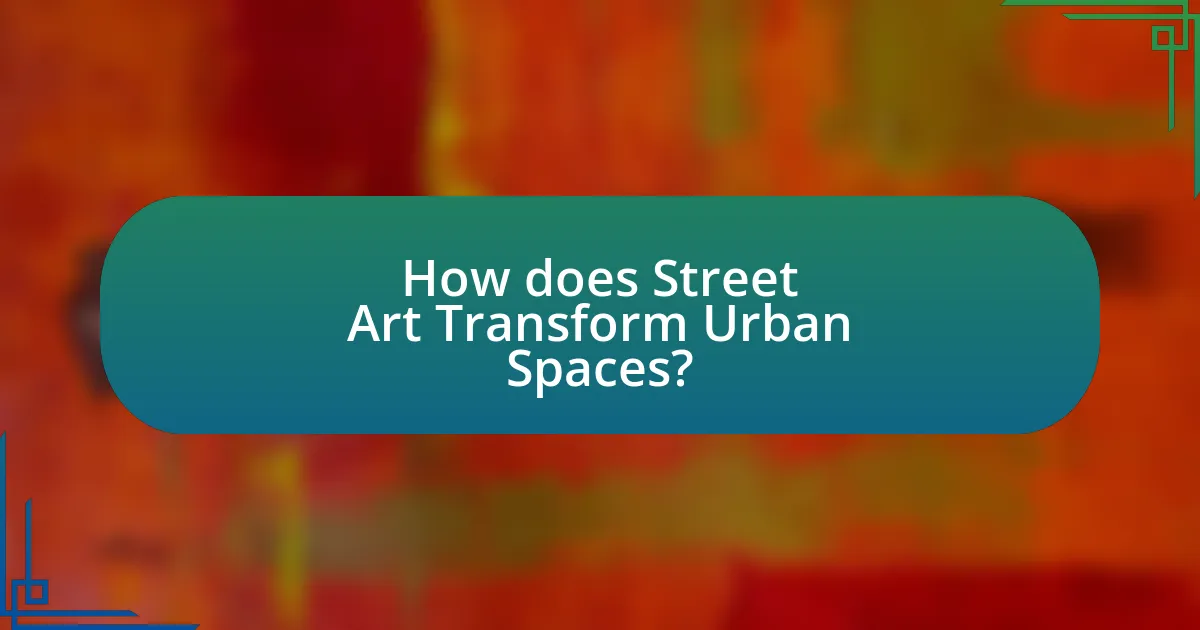
How does Street Art Transform Urban Spaces?
Street art transforms urban spaces by enhancing visual appeal, fostering community engagement, and promoting social commentary. This form of artistic expression revitalizes neglected areas, turning them into vibrant cultural hubs. For instance, cities like Berlin and Melbourne have seen significant increases in tourism and local pride due to their street art scenes, which attract visitors and encourage local businesses. Additionally, studies indicate that street art can reduce crime rates by increasing foot traffic and community involvement, as seen in neighborhoods that have embraced murals and public art projects.
What aesthetic changes does street art bring to urban environments?
Street art brings vibrant colors, unique designs, and cultural expressions to urban environments, significantly altering their aesthetic appeal. This transformation enhances public spaces by introducing creativity and individuality, often turning dull or neglected areas into visually stimulating attractions. For instance, cities like Berlin and Melbourne have embraced street art, resulting in increased tourism and community engagement, as noted in studies highlighting the economic benefits of urban art initiatives. Additionally, street art often reflects social issues and local narratives, fostering a sense of identity and belonging among residents, which further enriches the urban landscape.
How does street art enhance the visual appeal of neglected areas?
Street art enhances the visual appeal of neglected areas by transforming dull, abandoned spaces into vibrant canvases that attract attention and engagement. This transformation often involves the use of bold colors, intricate designs, and thought-provoking themes, which can significantly uplift the aesthetic quality of the environment. Research indicates that areas with street art experience increased foot traffic and community interaction, as seen in cities like Berlin and Melbourne, where murals and graffiti have become tourist attractions. Additionally, studies show that street art can foster a sense of pride among local residents, contributing to community revitalization and encouraging further investment in the area.
What are the effects of street art on urban revitalization efforts?
Street art significantly contributes to urban revitalization efforts by enhancing public spaces, attracting tourism, and fostering community engagement. For instance, cities like Berlin and Melbourne have experienced increased foot traffic and economic activity in areas where street art is prevalent, as it draws visitors and locals alike. Additionally, studies indicate that neighborhoods with vibrant street art see a reduction in crime rates and an increase in local pride, which further stimulates investment and development. The presence of street art can transform neglected areas into cultural hubs, thereby improving the overall aesthetic and social fabric of urban environments.
How does street art contribute to tourism and local economies?
Street art significantly contributes to tourism and local economies by attracting visitors who seek unique cultural experiences. Cities known for vibrant street art, such as Berlin and Melbourne, report increased foot traffic and tourism revenue, with studies indicating that street art can boost local business sales by up to 30%. Additionally, street art festivals and guided tours generate income for local artists and businesses, further enhancing economic activity. For instance, the Wynwood Walls in Miami has transformed a previously neglected area into a thriving tourist destination, demonstrating how street art can revitalize neighborhoods and stimulate economic growth.
What types of street art attract tourists to urban areas?
Murals and graffiti are the primary types of street art that attract tourists to urban areas. Murals often feature large, colorful designs that tell a story or convey a message, making them visually appealing and culturally significant. For example, cities like Berlin and Wynwood in Miami have become tourist hotspots due to their vibrant mural scenes, which showcase local artists and reflect the community’s identity. Graffiti, particularly when it includes intricate designs or social commentary, also draws attention; cities like New York and London are renowned for their graffiti culture, which has historical roots and continues to evolve. The presence of these art forms not only enhances the aesthetic of urban spaces but also encourages cultural tourism, as visitors seek to experience the unique artistic expressions that define these locales.
How do local businesses benefit from street art initiatives?
Local businesses benefit from street art initiatives by attracting increased foot traffic and enhancing their visibility. The presence of vibrant street art can transform a neighborhood into a cultural hotspot, drawing in both locals and tourists. For instance, a study by the University of California found that areas with street art saw a 20% increase in pedestrian traffic, which directly correlates to higher sales for nearby businesses. Additionally, street art can create a unique identity for a location, encouraging community engagement and fostering a sense of pride among residents, which further supports local commerce.
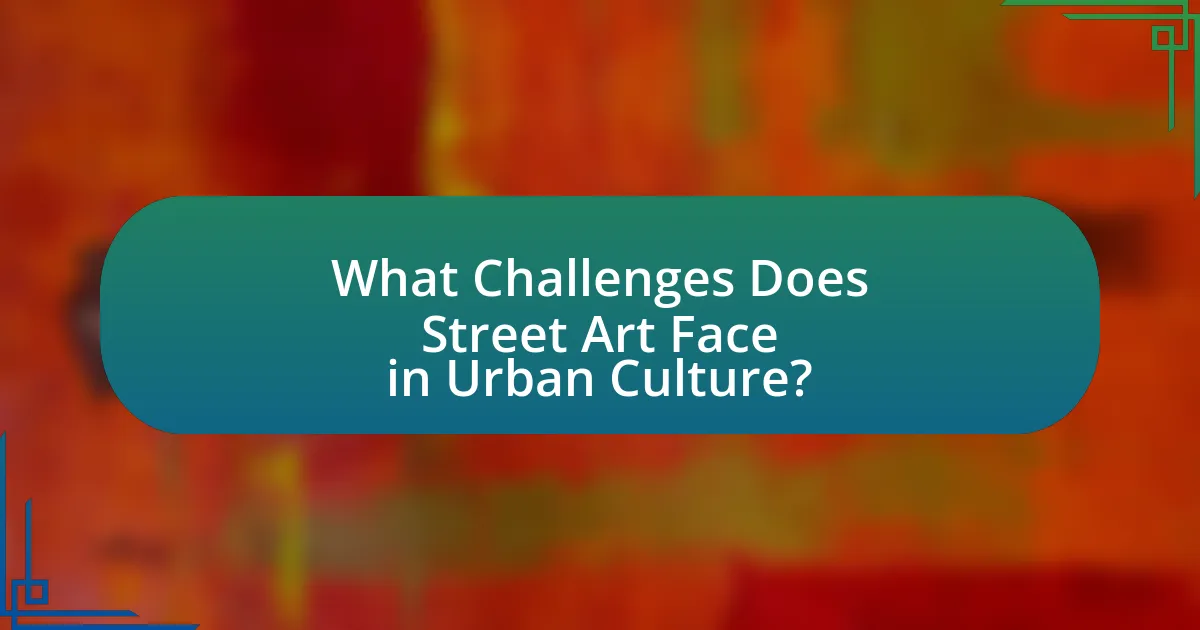
What Challenges Does Street Art Face in Urban Culture?
Street art faces significant challenges in urban culture, primarily due to legal restrictions, societal perceptions, and the commercialization of art. Legal restrictions often classify street art as vandalism, leading to fines and removal by authorities, which stifles artistic expression. Societal perceptions can vary, with some viewing street art as a legitimate form of cultural expression while others see it as a nuisance or crime, impacting artists’ ability to gain acceptance. Furthermore, the commercialization of street art can dilute its original intent, as artists may feel pressured to conform to market demands rather than pursue authentic creative expression. These challenges highlight the complex relationship between street art and urban environments, where artistic freedom often clashes with regulatory and societal norms.
What legal issues surround street art in urban settings?
Legal issues surrounding street art in urban settings primarily involve copyright infringement, property rights, and municipal regulations. Street artists often create works on private or public property without permission, leading to potential legal action from property owners or local governments. For instance, in the United States, the Visual Artists Rights Act of 1990 grants artists certain rights over their works, but these rights can conflict with property owners’ rights to control their property. Additionally, cities may have ordinances that prohibit unauthorized graffiti, resulting in fines or removal of the artwork. These legal frameworks create a complex environment where street art can be both celebrated and contested, reflecting ongoing tensions between artistic expression and legal constraints.
How do laws and regulations impact street artists?
Laws and regulations significantly impact street artists by determining the legality of their work and the spaces in which they can create. For instance, many cities have strict anti-graffiti laws that criminalize unauthorized street art, leading to potential fines or arrest for artists. Conversely, some municipalities have implemented designated areas for street art, which can provide artists with legal avenues to express their creativity. Research indicates that cities with supportive regulations often see a flourishing street art scene, which can enhance urban culture and attract tourism. For example, cities like Melbourne and Berlin have embraced street art through legal frameworks, resulting in vibrant public art that contributes to local identity and economy.
What are the consequences of vandalism perceptions on street art?
Perceptions of vandalism significantly impact street art by influencing public acceptance and the legal status of such artworks. When street art is viewed primarily as vandalism, it often leads to increased removal efforts by authorities, resulting in the loss of artistic expression and cultural commentary in urban spaces. For instance, cities like New York have seen a rise in anti-graffiti initiatives that prioritize the eradication of street art, which diminishes the visibility of artists and their messages. Furthermore, negative perceptions can deter artists from creating new works, stifling creativity and reducing the diversity of urban art. This dynamic creates a cycle where the stigma surrounding street art as vandalism undermines its potential to enrich urban culture and community identity.
How do community attitudes affect the acceptance of street art?
Community attitudes significantly influence the acceptance of street art, as positive perceptions can lead to greater appreciation and support for such artistic expressions. When communities view street art as a form of cultural enrichment or social commentary, they are more likely to embrace it, often resulting in initiatives that promote and protect these artworks. For instance, a study by the University of California, Los Angeles, found that neighborhoods with supportive attitudes towards street art reported higher levels of community engagement and pride, which in turn fostered a more vibrant urban culture. Conversely, negative attitudes, often stemming from perceptions of vandalism or disorder, can lead to the removal or defacement of street art, limiting its presence and impact in the community.
What factors contribute to the polarization of opinions on street art?
The polarization of opinions on street art is primarily influenced by cultural, legal, and aesthetic factors. Cultural factors include differing societal values and perceptions of art, where some view street art as a legitimate form of expression while others see it as vandalism. Legal factors arise from the lack of clear regulations governing street art, leading to conflicts between artists and authorities. Aesthetic factors involve personal taste, where individuals may appreciate the creativity and vibrancy of street art or reject it as an eyesore. These factors contribute to the divided perspectives on street art within urban environments.
How can street artists engage with communities to foster acceptance?
Street artists can engage with communities to foster acceptance by creating inclusive art that reflects local culture and addresses social issues. This engagement can be achieved through collaborative projects that involve community members in the artistic process, allowing them to express their identities and concerns. For instance, community mural projects have been shown to enhance social cohesion and promote dialogue among diverse groups, as evidenced by the “Murals for Change” initiative in various cities, which successfully brought together residents to discuss and depict their shared experiences. By prioritizing themes relevant to the community, street artists can build trust and encourage a sense of belonging, ultimately leading to greater acceptance of diverse perspectives within urban environments.
What are best practices for promoting street art in urban areas?
Best practices for promoting street art in urban areas include engaging local communities, obtaining necessary permits, and collaborating with artists and organizations. Engaging local communities fosters support and appreciation for street art, as seen in initiatives like the Mural Arts Program in Philadelphia, which has successfully involved residents in the creation and maintenance of murals. Obtaining necessary permits ensures that street art is legally sanctioned, reducing the risk of vandalism and promoting a positive perception of the art form. Collaborating with artists and organizations, such as public art festivals, can enhance visibility and attract tourism, as demonstrated by events like the Wynwood Walls in Miami, which has transformed a neighborhood through curated street art. These practices collectively contribute to a vibrant urban culture that values artistic expression.
